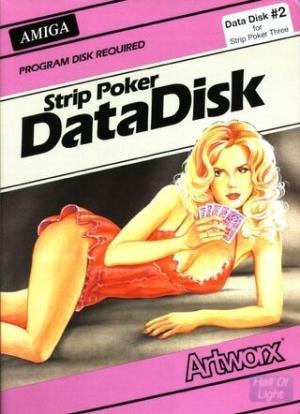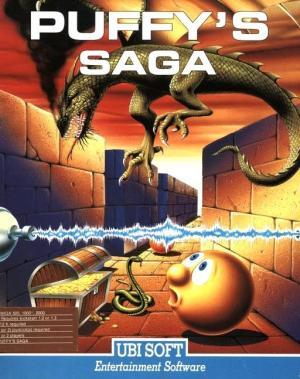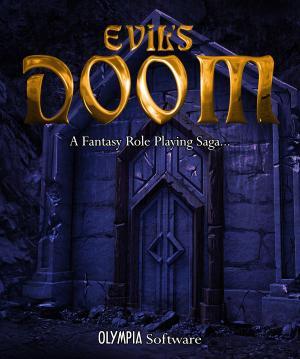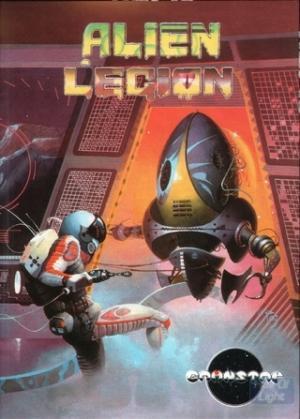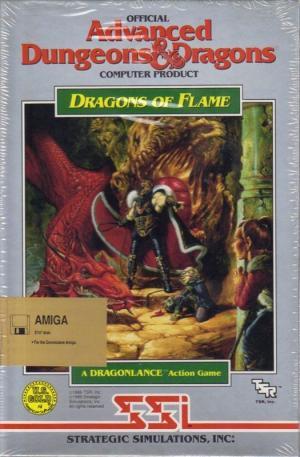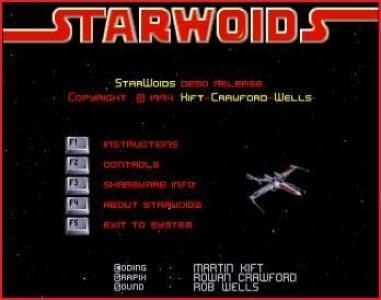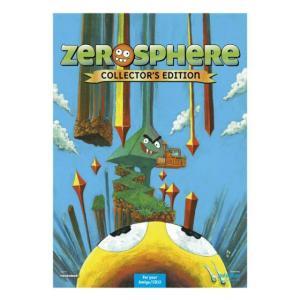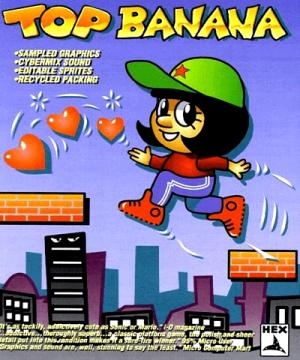
| Console: | Amiga |
| TV Standard: | Other |
| Release Date: | 1992-01-01 |
| Players: | 1 |
| Co-op: | No |
| ESRB: | Not Rated |
| Type: | Platform |
Top Banana is an environmentally-themed platform game produced by Hex and Psycore for the Acorn Archimedes in 1991 and ported to the Amiga and Atari ST in 1992. The chief artist and coder was Miles Visman, with supporting graphics and sound by Karel Dander, and supporting graphics by Sophie Smith, Robert Pepperell and Matt Black. Top Banana was released using recycled cardboard packaging, furthermore being advertised as being the 'first video game with recycled packaging'. Top Banana's plot is about trying to save the environment from pollution using love.
Top Banana is heavily influenced by techno and rave culture, and the game features a techno music video as an introduction. Reception for Top Banana was polarized; some reviewers praised the game's techno soundtrack and 'original' environmental plot, while others heavily criticized the game due to its 'repetitive' and 'difficult' gameplay and 'difficult to parse' graphics. The game's graphics and sound are left uncompressed, allowing the player to edit them, something that the README included alongside the game encourages.
"Our planet is under threat - not from slimy aliens or evil wizards but from direct consequences of our own greed and stupidity. Every moment sees further demolition of the rainforest, more leaking nuclear waste, land floods caused by melting ice caps and much needed food rotting in locked warehouses. Your task is to combat those forces which are worlds tilts into oblivion you must redress the balance through positive action. To aid you in this task you are invested with a great power - that power is Love. Use this power to repel the agents of destruction. By spreading Love your enemies will vanish, or even begin to help you. You will be able to stem the tide of flood, neutralise the acid rain and release the hoarded fruits of the World's produce for all to share. If you succeed then you will have proved your skill and courage in the material world. Consequently, you will be offered the opportunity to seek ultimate wisdom in the Mind-Scape and achieve the status of Top Banana."
Top Banana is a platformer with the goal of each level being to reach the top of the level. The heroine, KT, must travel through psychedelic levels while jumping across platforms and throwing lovehearts to convert planet-damaging enemies into energising fruit. The enemies include Corprats, Popstars, Chainsaws and Bulldozers. Much like Rainbow Islands, water that damages the player rises from the bottom of the level to motivate the player to ascend to the top of the level quickly. However, in Top Banana the water is not an instant kill, and instead deals 1 point of damage to the player, the water then resets to the bottom of the level, and continues to rise. The player has one life and can take 5 hits before dying; upon death all progress in the game is lost, and the player must start again from the beginning of the game. KT's health is depicted visually by her portrait in the lower left, and parts of it disappear as health is lost. Fruit that the player may collect throughout the game does not replenish health, and instead awards points, which have no tangible reward other than the player may place in the high score table if enough points are collected.
Enemies are defeated in one hit, except for bosses which take several, and stationary enemies such as skulls that cannot be defeated and must be avoided. Some enemies can move through platforms, and towards the player directly. Bosses in Top Banana include a digitized photo of a man's head surrounded by circling dollar signs, a mecha robot, a motorcycle police officer's helmet combined with a spider, and a convulsing knobbled multi-coloured sphere, referred to in the manual as the "psychesphere of Enlightenment".
Top Banana features bosses at the end of each stage; each stage has several levels, and have differing background graphics and enemies. To finish a level, a picture of a woman's head at the top of the level must be touched by the player, and stages with bosses are completed when the boss is defeated. Top Banana has four stages: the Rain Forest, the Metal-City, the Temple, and the Mind-Scape. The background graphics in each stage are randomly selected from a set of graphics matching the stage's theme; each time the level is loaded the graphics may differ, although platforms remain fixed in the same locations. Upon finishing a level, the game displays a phrase randomly selected from a list of phrases as the next level loads, including "Beware, Behave", "Recycle The Hype" and "Get Up Get Down". In later stages there are traps that if walked into, slow movement, reverses the game's controls, as well as inverts the colors of the level's graphics for several seconds. Upon taking damage, the player phases through the platforms they are on for several seconds, causing the player to lose progress. There are checkpoints in each level that, upon being reached, the player cannot fall through. Blue flowers in levels may be turned into moving platforms by shooting them.
As a copy-protection measure, the player is prompted to enter a word from a specific page and line in the manual upon starting the game.
Many of Top Banana's sprites are taken from videos and television for use in the game, much in the same way audio may be sampled in music. Musician and Coldcut member Matt Black worked on Top Banana, and later members of the Hex multimedia group formed Hexstatic. Top Banana was playtested in the Netherlands. Top Banana cost 329 Swedish Kronor in 1992.
Top Banana's developer & publisher Hex is also known as Hardwire, a company specializing in computer graphics work for music videos. Hex spokesman Robert Pepperell stated in an article in a May 1991 issue of The One that Top Banana was developed because Hex believed "a computer game would be an interesting challenge", and because "Most games look rather sterile. We wanted to do something really different and positive. The technique of video sampling has never been used in a game before. Top Banana really looks and sounds completely different to any other computer game yet written." Matt Black was initially going to make a cameo appearance in Top Banana as a manic bongo player, but this is absent in the final game. The screenshot of Top Banana featured in The One's article is drastically visually different to that of the final game, with a differing artstyle, a top-down perspective as opposed to a 2D one, and depicts a performance hall with a piano, a location absent in the final game.
